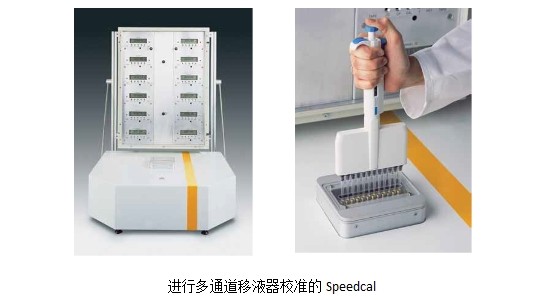Common methods for automated equipment fault detection
Pipettes are standard testing, measuring and metering equipment. Laboratory operators use pipettes every day to carry out a large number of pipetting tasks. The long-term use of a spring-loaded ammunition by a pipette can cause deformations and errors. GLP and European standards require that the pipette must be tested regularly and that it requires a quick check in addition to regular tests. Pipette calibration is expensive and time consuming, and the equipment and environment are also more demanding. However, the pipette calibration program centered on the balance application can facilitate your work. Let's take a look at the laboratory balance in pipetting. Device calibration.
The basic principle of calibration using the more common piston pipette is to weigh the liquid sucked by the pipette on the balance, calculate the volume according to the weight and density of the liquid, and compare with the calibrated capacity of the pipette. Pipette calibration is usually based on the standard ISO8655 and JJG-646-2006 pipette verification procedures.
ISO8655 specifies the instruments used for pipette calibration, test procedures, test environment, results, and calibration reports. To perform pipette calibration quickly, accurately, and conveniently, step-by-step procedures can be performed in accordance with the pipette calibration contained in the Sartorius Cubis Q-App. The usual pipette calibration is performed: performance test, basic calibration, Strengthen the five steps of calibration, typical test, and calibration. After the operation, the PieceTrailer product software package can provide calibration reports that meet the requirements of ISO8655, ISO17025, and GLP. In the hardware of pipette calibration, choose different balances according to different range of pipettes, and in order to avoid evaporation of liquid, you can use the evaporating gas valve as balance accessories. Note that the balance for pipette calibration You must use an E2 weight every day for calibration. In addition, the Sartorius Climate Workstation has also been well applied due to the high environmental requirements of pipette calibration.

There are still many users who use multi-channel pipettes but the calibration of multi-channel pipettes is very vexing because each channel is calibrated with about 4 hours of temperature treatment, cleaning, lubrication of the piston, With the correction of three points, multi-channel users have to repeat the above process 8-12 times, and the work efficiency is very low. If you combine 12 weigh modules and develop a balance that can weigh up to 12 channels of sample at the same time, you can increase the working efficiency by 8-12 times. The pipette calibration balance SpeedCal should be shipped under this requirement. Health, 30 minutes of 12-channel pipettes can be completed in 3 minutes to solve the troubles of such users.

Is there an application that uses the weighing principle for calibration or inspection in your work? Did you develop a special weighing container because of the special sample? Have you done any expansion to make your balance work high-throughput? You are welcome to participate in "Weighing is endless, no limit to creativity - no matter what the limits of the laboratory scale application contest." Do not ignore your even a small application, perhaps it can change the experimental life of millions of people!
The basic principle of calibration using the more common piston pipette is to weigh the liquid sucked by the pipette on the balance, calculate the volume according to the weight and density of the liquid, and compare with the calibrated capacity of the pipette. Pipette calibration is usually based on the standard ISO8655 and JJG-646-2006 pipette verification procedures.
ISO8655 specifies the instruments used for pipette calibration, test procedures, test environment, results, and calibration reports. To perform pipette calibration quickly, accurately, and conveniently, step-by-step procedures can be performed in accordance with the pipette calibration contained in the Sartorius Cubis Q-App. The usual pipette calibration is performed: performance test, basic calibration, Strengthen the five steps of calibration, typical test, and calibration. After the operation, the PieceTrailer product software package can provide calibration reports that meet the requirements of ISO8655, ISO17025, and GLP. In the hardware of pipette calibration, choose different balances according to different range of pipettes, and in order to avoid evaporation of liquid, you can use the evaporating gas valve as balance accessories. Note that the balance for pipette calibration You must use an E2 weight every day for calibration. In addition, the Sartorius Climate Workstation has also been well applied due to the high environmental requirements of pipette calibration.

There are still many users who use multi-channel pipettes but the calibration of multi-channel pipettes is very vexing because each channel is calibrated with about 4 hours of temperature treatment, cleaning, lubrication of the piston, With the correction of three points, multi-channel users have to repeat the above process 8-12 times, and the work efficiency is very low. If you combine 12 weigh modules and develop a balance that can weigh up to 12 channels of sample at the same time, you can increase the working efficiency by 8-12 times. The pipette calibration balance SpeedCal should be shipped under this requirement. Health, 30 minutes of 12-channel pipettes can be completed in 3 minutes to solve the troubles of such users.

Is there an application that uses the weighing principle for calibration or inspection in your work? Did you develop a special weighing container because of the special sample? Have you done any expansion to make your balance work high-throughput? You are welcome to participate in "Weighing is endless, no limit to creativity - no matter what the limits of the laboratory scale application contest." Do not ignore your even a small application, perhaps it can change the experimental life of millions of people!
Flange Gasket,Gasket Seal,Spiral Gasket,Ring Joint Gasket
YUHONG GROUP CO.,LIMITED , https://www.jessro-pipefittings.com